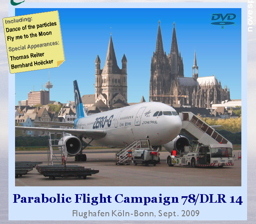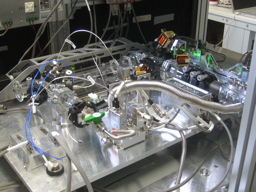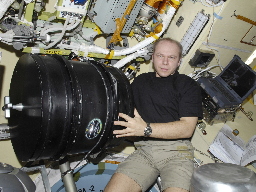''Plasma Crystal''
Latest News!
|
Dezember 2010
|

Kosmonauten zu Besuch im MPE:
Oleg Kotov, Mikhail Tjurin, Juri Baturin.
(Zum Vergrößern anklicken)

Russische Raumfahrer zu Gast
in Garchinger Grundschule.
(Zum Vergrößern anklicken)
|
PK-3 Plus-Symposium: Russische Kosmonauten besuchen MPE und garchinger Schule
Wie schon in den vergangenen Jahren lud die
Theorie-Gruppe des MPE zu einem zweitägigen Plasmakristall-Symposium ein,
um die neuesten Ergebnisse des aktuellen Plasmalabors ''PK-3 Plus''
an Bord der ISS unter den Kooperationspartnern auszutauschen. Der Einladung
folgten zahlreiche Gäste aus Russland (JIHT/RAS (vorm. IHED), RKK Energija,
Tsup, Gagarin Kosmonauten-Trainingszentrum), Frankreich (Universität
Orléans), Norwegen (Universität Tromsø), Japan,
der Universität Kiel, der ESA, des DLR, sowie Industriepartner aus
Deutschland (Kayser-Threde). Junge Wissenschaftler des MPE präsentierten
Ergebnisse aus Experimenten mit PK-3 Plus, unsere russischen
Partner resümierten den Stand der Experimente mit Komplexen
Plasmen in der Schwerelosigkeit und zeigten interessante Einblicke in
den geplanten weiteren Ausbau des russischen Segments der Internationalen
Raumstation für die Forschung. Weitere Beiträge des MPE thematisierten
die für die nahe Zukunft für die Raumstation geplanten und z.T.
bereits im Bau befindlichen Plasmaexperimente PK-4 und PlasmaLab.
Unter der russischen Delegation befanden sich u.a. die Kosmonauten
Juri Baturin, Mikhail Tjurin und Oleg Kotov, die während ihres
Aufenthalts auf der ISS jeweils Plasmakristall-Experimente durchführten.
(Siehe Januar.)
Mit einem kurzweiligen Filmbeitrag nahmen sie die Zuschauer mit an Bord
der Raumstation und gaben faszinierende Einblicke in das Leben und die
Arbeit im Erdorbit.
Zwei der russischen Raumfahrer konnten im Rahmen ihres Aufenthalts in Garching
für einen Besuch der Grundschule Ost gewonnen werden. Arrangiert wurde der
Besuch durch den MPE-Mitarbeiter Sergey Khrapak und dessen Frau. Oleg Kotov
(45, Doktor der Medizin) und Mikhail Tjurin (50, Ingenieur für Luft-
und Raumfahrttechnik) wurden in der Aula der Schule von Rektorin Barbara
Streidl, zahlreichen Kindern der Grundschule und des Physik-Leistungskurses
des benachbarten Gymnasiums, sowie interessierten Eltern begeistert empfangen.
(Bild links.)
Michael Kretschmer vom MPE stellte die beiden vor und erläuterte kurz
den Hintergrund dieser internationalen Zusammenarbeit zwischen den Raumfahrern
und den Wissenschaftlern des Max-Planck-Instituts.
Nach zwei Kurzfilmen über den Aufenthalt auf der Internationalen
Raumstation ISS, die von Kotov, Tjurin und Kretschmer live kommentiert wurden,
bot sich die Gelegenheit für die Schüler, Fragen
zu stellen, was ausgiebig genutzt wurde; dutzende Finger schnellten
in die Höhe und zeigten den Weltraumfahrern das große Interesse
der Kinder am Thema Raumfahrt. Alle Fragen zu Start und Landung, nach dem
Essen, dem Schlafen, dem Tagesablauf und dem Werdegang eines Astro- bzw.
Kosmonauten wurden aus erster Hand beantwortet. Auch der Spaß kam dabei
nicht zu kurz: ''Wie funktioniert die Weltraumtoilette?'' - Tjurin: ''Gut.''
Die älteren Schüler erkundigten sich nach Risiken des Aufenthalts
im Weltraum für Mensch und Maschinen durch kosmische Strahlung. Und
alle im Auditorium waren ergriffen von Tjurins Worten, dass der Aufenthalt
im Weltraum zwar ein einzigartiges Erlebnis sei, das jeder Raumfahrer
jederzeit wieder zu erleben bereit wäre, jedoch das schönste sei,
nach der Landung aus der Schwerelosigkeit wieder die Erde zu spüren,
andere Menschen zu sehen und vor allem wieder bei der Familie zu sein.
Zum Abschluss bedankte sich die Schule herzlich bei allen Akteuren und die
Kosmonauten übergaben signierte Gastgeschenke, so dass den Schülern
dieser 'Besuch aus dem Weltraum' noch lange in Erinnerung bleiben dürfte.
Weitere Berichte aus der Lokalpresse:
- Zwei Männer,
die aus dem All kommen (Münchner Merkur)
- Am schönsten
ist die Landung auf der Erde (Süddeutsche Z.)
|
October 2010
|

|
Video clips from the 14th DLR parabolic flight campaign
In September 2009 staff members of
MPE and JIHT (formerly known as IHED, Moscow)
participated in the 14th parabolic flight campaign organized
by the German Aerospace Center DLR at the Cologne airport. The aim was
to test for the first time under microgravity conditions the new ''Zyflex''
plasma chamber that will – within the upcoming
''PlasmaLab'' program – continue the successful research of MPE on
complex plasmas onboard the International Space Station.
Like the last times the capaign was documented on video. Two clips
of that video are presented here.
''Dance of the Particles'' is a music video clip that combines
the recorded data – the dynamics of charged microparticles inside
a room temperature plasma – with classical music.
''Fly me to the Moon'' is a short educational film that
deals with basic physics phenomena during a parabolic flight.
Enjoy!
If you like the clips why not have a look into our
video archive?
Most clips are re-released now in the modern MPEG4 format (using the h.264
codec, for experts).
Any problems playing the videos? Try using QuickTime:
Free Download!
|
September 2010
|

PK-4/IBP parabolic flight setup,
click to enlarge.
(Courtesy of M. Kretschmer)
|
'First Light' from PK-4/IBP
The PK-4 plasma experiment, being under development at the MPE
since the last years, took another step towards its destination:
For the first time the DC discharge tube was operated in a configuration
that is similar to its future use onboard the International Space
Station ISS.
To operate the device on the ISS the model used in the lab has to be
developped towards a flight model that is reduced in size and weight
and is at the same time more robust. Therefore the glass tube containing
the plasma was mounted onto a carrier plate (the 'integrated base plate',
IBP) together with all the necessary
modules for electronics, optics, gas, vacuum and cameras. The IBP will
be mounted inside a sealed
container with a length of ca. 70cm
that will be accommodated inside the EPM rack of the European Columbus
module on the space station.
Now the PK-4 IBP is mounted inside the parabolic flight rack where it
is to be tested for the first time in microgravity during the ESA
parabolic flight campaign in October. Scientists and engineers of MPE
travel to Bordeaux, France, where they install PK-4/IBP inside the
Airbus A300 'Zero-G' to test all the components in detail during
the zero-g phases of the flight.
PK-4 is supported by ESA and is to be launched to the International
Space Station in 2012 to continue the successful work of the MPE
plasma experiment facilities ''PKE-Nefedov'' and ''PK-3 Plus''.
In opposite to these two RF devices PK-4 uses a DC/HV generated
plasma to study mainly complex plasmas in the liquid state.



First Light from the PK-4/IBP plasma tube
(Click to enlarge!)
|
January 2010
|

Cosmonaut Oleg Kotov with
PK-3 Plus onboard the ISS
(© RKK Energia/MPE)
|
25th Plasma Crystal Mission on the ISS
In the end of January the 25th mission with the Plasma Crystal Experiment
takes place onboard the International Space Station ISS using MPE's
PK-3 Plus plasma science facility for the 12th time.
PK-3 Plus resides on the ISS since
2006. It replaces the former plasma laboratory
PKE-Nefedov which happened to be the first physical experiment on the
space station in 2001. Scientists and engineers from MPE and the Russian JIHT
institute lead this experiment mission from the Russian space control
center located in Korolyov in the periphery of Moscow. On the ISS Russian
cosmonaut Oleg Kotov – flight engineer of the
Expedition 22 crew – will perform the experiments
on three consecutive days for ca. 90 minutes each. For the first time PK-3
Plus will be located inside the
MIM-2 module of the ISS. Also for the first time additional
NASA relay satellites will provide nearly total video coverage of the experiment
run. This helps of course a lot to monitor the experiments on the ground.
The main subject of this PK-3 Plus mission is to study binary mixtures
where two types of microparticles inside the plasma are present. This kind of
mixture is common in the (industrial) processing of granular media and in
mixtures of two fluids, just like water and oil. In the micro-g environment
of the space station these mixtures will be observed with video cameras and
analysed on the individual particle level which is not possible in real fluids
on Earth.
As in former missions our colleague Mierk Schwabe will report in her
 Blog what's going on in Moscow. (German only!) Blog what's going on in Moscow. (German only!)
Further information: Press release by MPE.
|
Updated: 2011-01-03
Contact: Michael Kretschmer

|